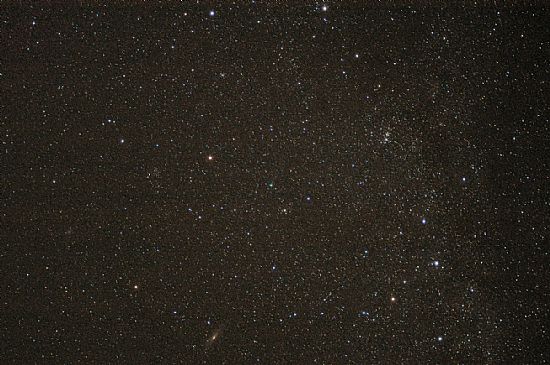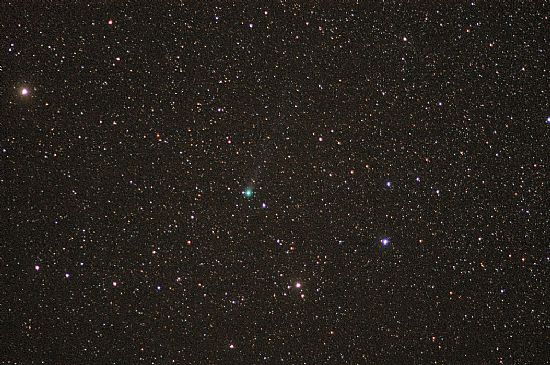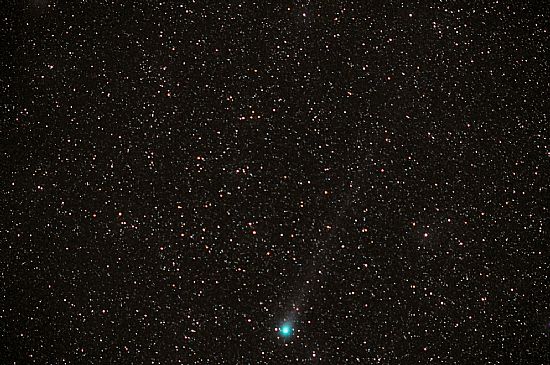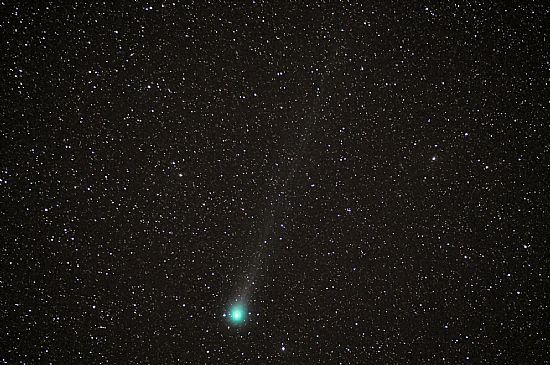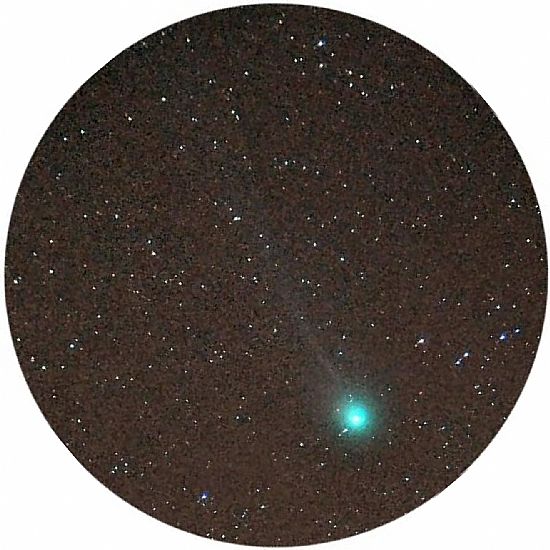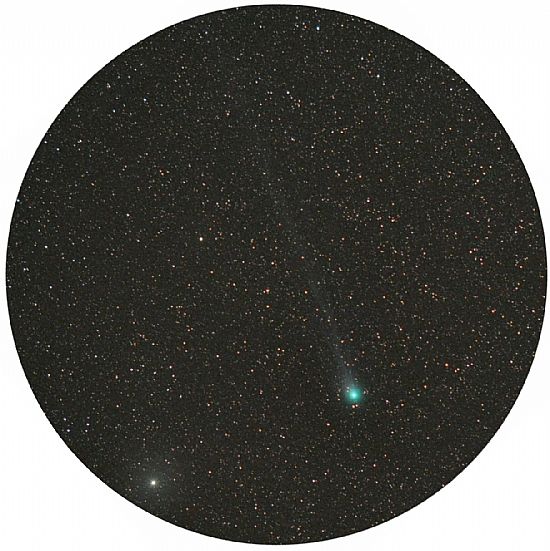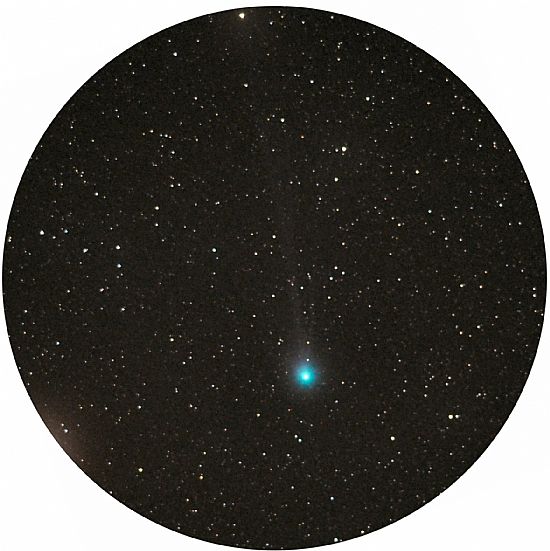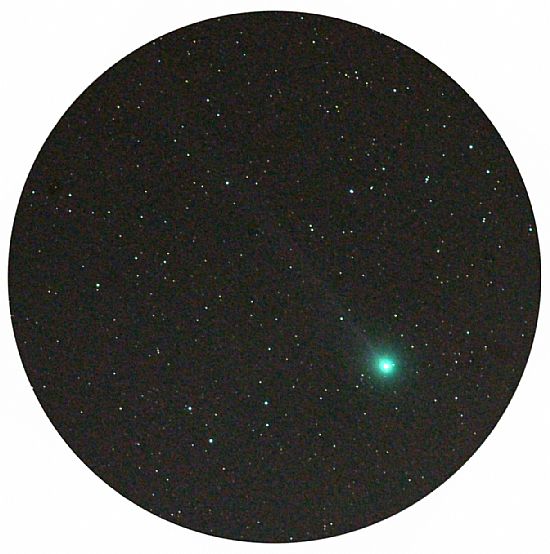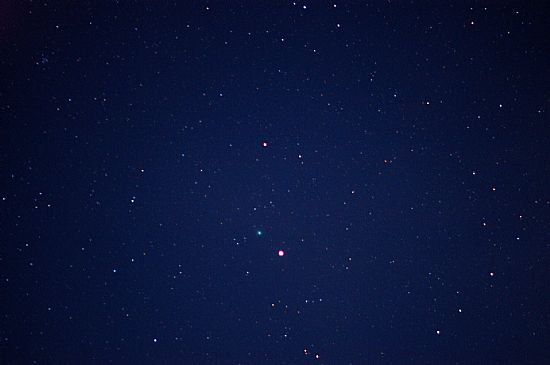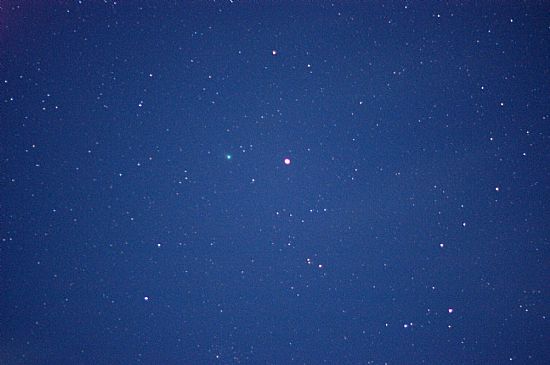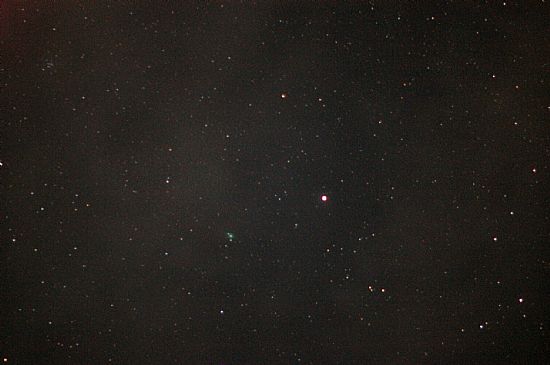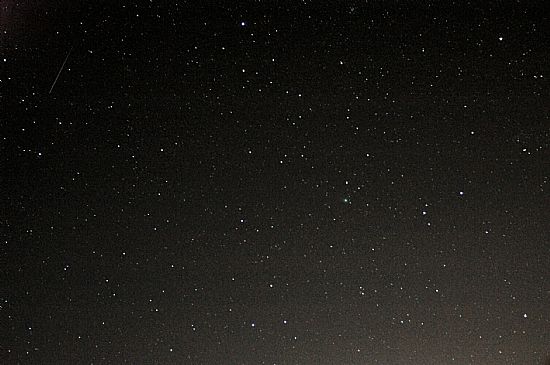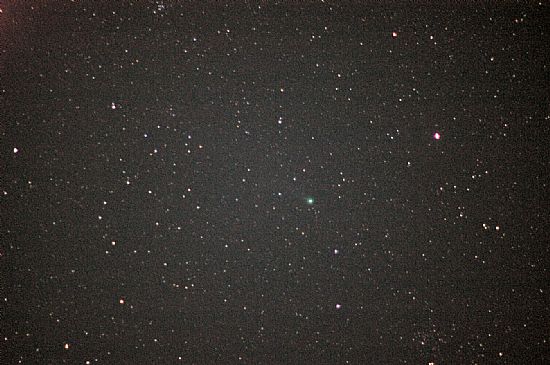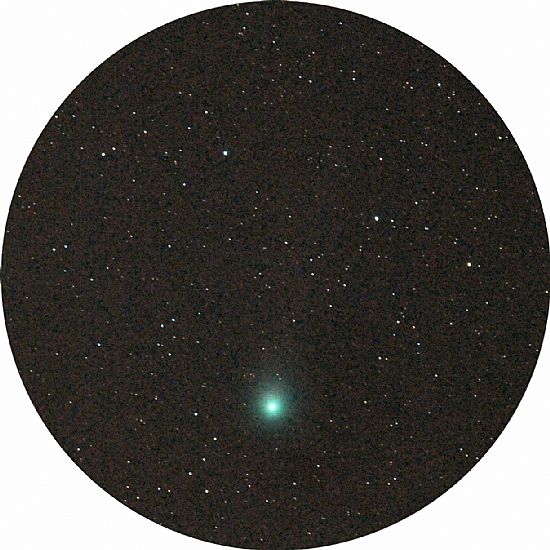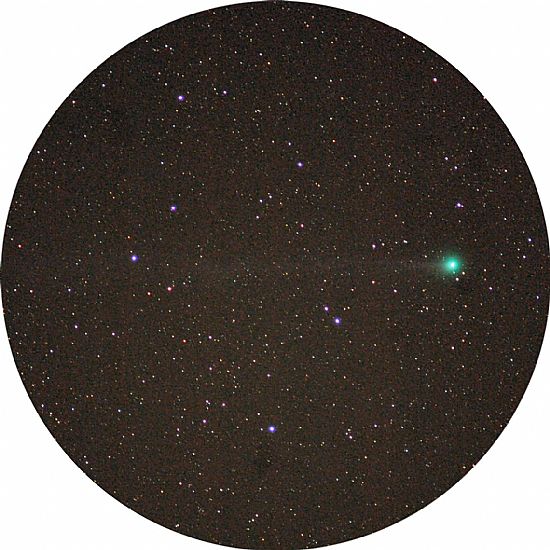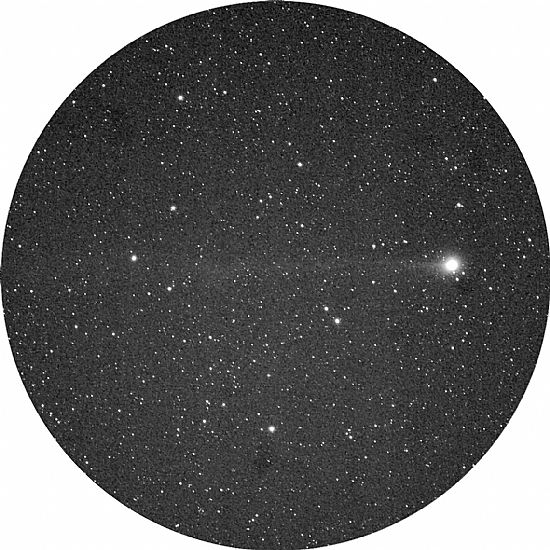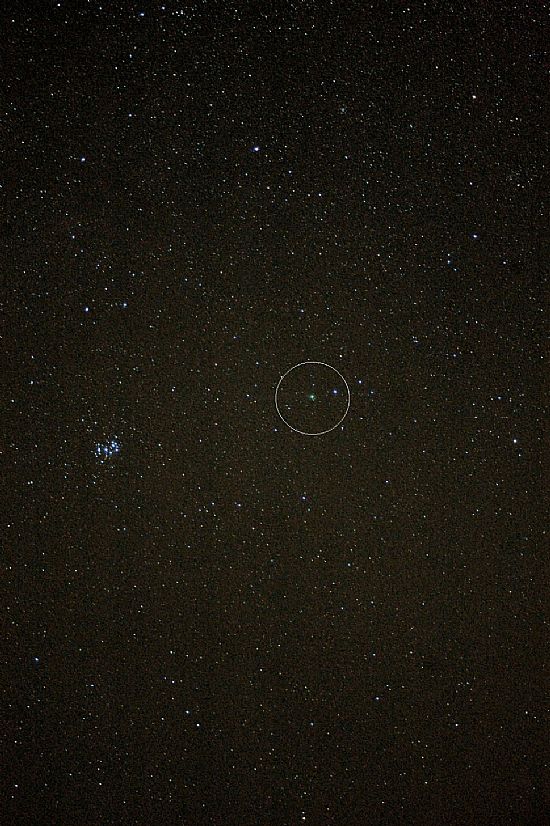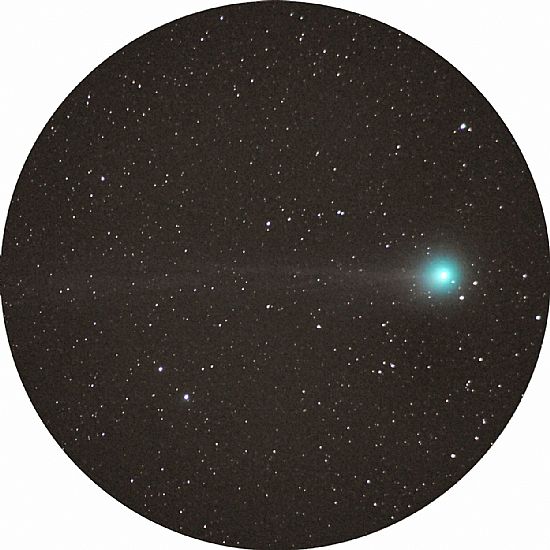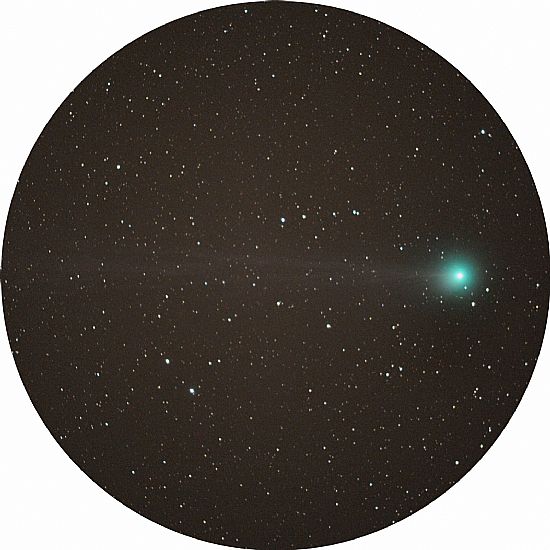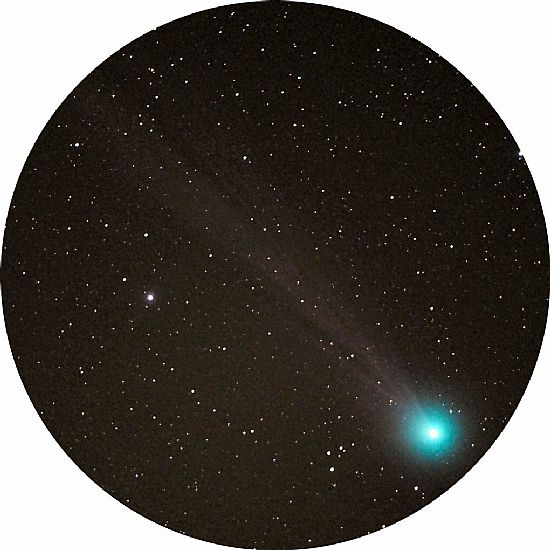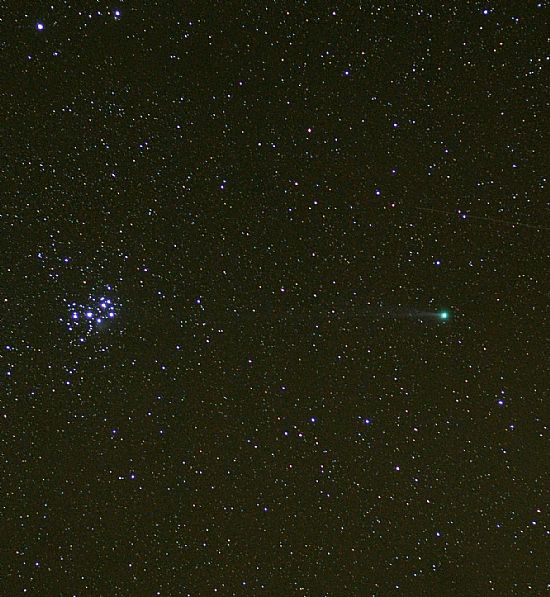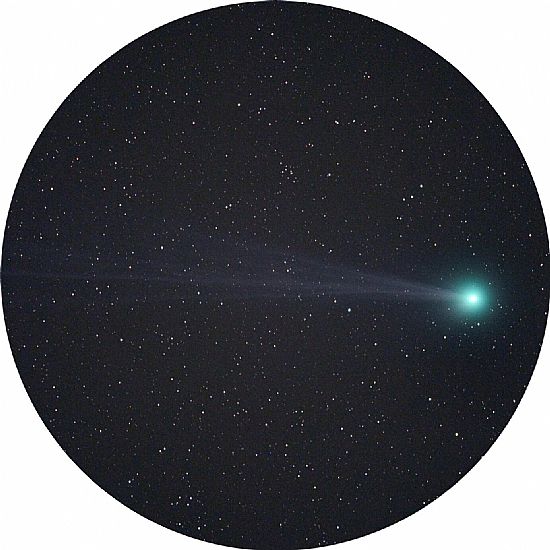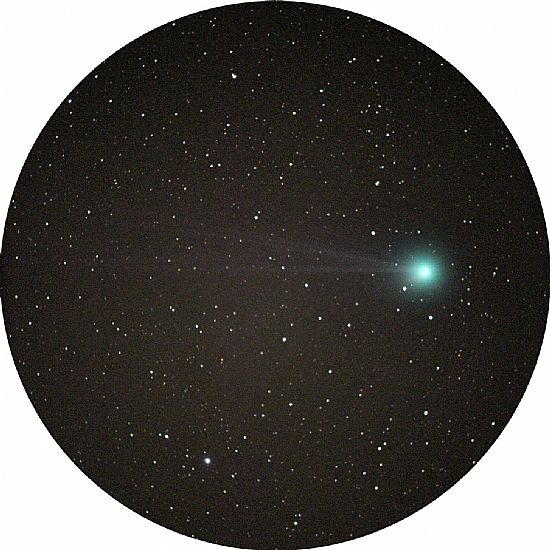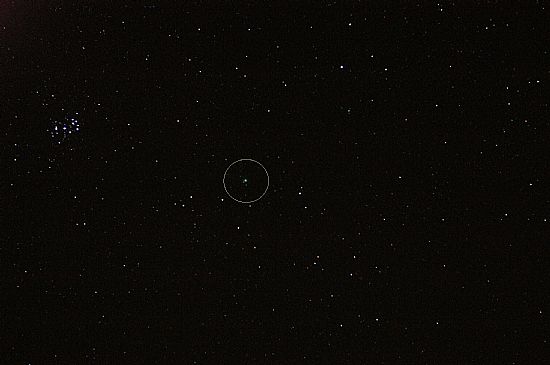 NORTHERN SKIES | sitemap | log in NORTHERN SKIES | sitemap | log in
|
 |
||
| This is a free Spanglefish 1 website. | ||
Comet Extra2015 March 01: Comet C/2014 Q2 Lovejoy: continuation page.
2015 February 26. Comet C/2014 Q2 Lovejoy. Another day of "blustery" showers leading to some clear intervals early evening and night but with a Moon at 62% phase high up in constellation Taurus and thus compromising imaging for the comet. A cold wind making for uncomfortable conditions; in the event, work was restricted to some 30 minutes using wide-field lenses, together with the 300mmf/2.8 and 500mm f/4.
2015 February 20, 21h 08m UT. A 8 sec. exposure (Nikkor 105mm f/1.8) D100 SLR ISO 500. The brightest stars in the field (8.7° x 12.5°) are those from Cassiopeia (right). The comet is a little below and left of centre. (Left click to enlarge.)
2015 February 20, 20h 41m UT. A 28.2 sec. exposure (Tokina 300mm f/2.8) D300 SLR ISO 2000. The brightest star in the field (dia. 2.6°) is TYC 3671-2315-1, mag. 6.35 spectral class K5III. (Left click to enlarge.)
Data for comet at 20h 40m UT: Right Ascension: 1h 34m 40s Declination: +54° 2' 34" Constellation: Perseus Altitude: 48° 21' Azimuth: 299° 32' Hour angle: 5h 20m Transit: 15h 22m Distance: 1.2660 AU (189.4 million km) Radius vector: 1.3567 AU (203.0 million km) Horizontal parallax: 6.95"
2015 February 20. Comet C/2014 Q2 Lovejoy. An evening of showers and moderate wind. Several attempts were made to secure an image of the comet but ending up with just two frames obtained with rain falling onto the instrument! The results were remarkably successful, all things considered.
2015 February 20, 20h 59m UT. A 50.5 sec. exposure (Tokina 300mm f/2.8) D300 SLR ISO 2500. The brightest star in the field (2.75° x 4.65°) and closest to the comet, is the variable star phi Persei mag. range: 3.96 – 4.11, spectral class B2Vpe, variable type GCAS.(Left click to enlarge.) Comet's data at time of observation: Right Ascension: 1h 40m 39s Declination: +51° 32' 26" Constellation: Perseus Altitude: 47° 59' Azimuth: 295° 2' Estimated integrated magnitude: 3.2 Elongation: 76.4° Distance: 1.1551 AU (172.8 million km) Radius vector: 1.3318 AU (199.2 million km) Horizontal parallax: 7.61"
2015 February 16. Comet C/2014 Q2 Lovejoy.
A clear, early evening with exceptional transparency lasting about one hour, possibly the best transparency we have experienced so far for this comet in a dark sky. The comet was imaged with 500mm f/4, 300mm f/2.8 and 105mm f/1,8, lenses, all of fine quality.
2015 February 16, 19h 24m UT. A 72.4 sec. exposure (Tokina 300mm f/2.8) D300 SLR ISO 2500. The brightest star in the field (2.75° x 4.65°) 51 Andromedae mag. 3.59 spectral class K3III. (Limiting magnitude18 on high resolution images.) Note the short trail (top right) from an artificial Earth satellite: a previous long exposure image had a satellite run through close to the comet's coma. The comet's tail may be detected for a little over 3°. (Left click to enlarge.)
2015 February 12. Comet C/2014 Q2 Lovejoy.
Comet Lovejoy seen against the backdrop of the Milky Way between constellations Andromeda and Cassiopeia.
The sky cleared in the early evening following a murky day of cloud and drizzle. Clarity was not uniform across the sky and cloud tended disperse and re-form as of your! However, the seeing quality was superior to that of the previous evening and night so that relatively long exposures were possible on the comet and its environs. Fine images with the 500mm f/4 will be included in the special feature for this comet to appear later. The very wide angle image below embraces a section of the Milky Way with Cassiopeia bottom right, Andromeda and Triangulum to the left (Galaxies M31 and M33) clearly discernable, the Perseus Double Cluster and a good deal more.
2015 February 12, 20h 01m UT. A 68 sec. exposure (Nikkor 28mm f/2.8. D100 SLR ISO 1000. The brightest star in the field (28° x 52° approx.) is alpha Persei (Mirfak), mag. 1.79 spectral class F5Ib. Andromeda Galaxy (M31), bottome left of centre; Comet: Lovejoy centre field.
2015 February 12, 20h 01m UT. A 30 sec. exposure (Nikkor 105mm f/1.8. D100 SLR ISO 1000. The brightest star in the field (8.7° x 12.5° approx.) is the famous double star gamma Andromedae (Almach), mag. 2.10.
2015 February 12, 20h 01m UT. A 46.9 sec. exposure (Nikkor 200mm f/2 stopped down to f/2.8, D300 SLR ISO 2500. The brightest star in the field (4° x 6° approx.) is 3 Persei, mag.: 5.70 spectral class K0IV.
2015 February 12, 20h 01m UT. A 70.1 sec. exposure (Tokina 300mm f/2.8) D300 SLR ISO 2500. The brightest star in the field (2.75° x 4.65°) is 3 Persei, mag.: 5.70 spectral class K0IV. (Limiting magnitude17.5 on high resolution image.) Left click to enlarge.
2015 February 08. Comet C/2014 Q2 Lovejoy.
We received the image below from a friend and colleague, Niel Morrison, working and living in the south of England not far from Gatwick.
2015 February 08, 20h 41m UT. OTA 90mm F5.5. A 20sec. exposure ISO 3400. The brightest star in the field (dia. 1.5° approx.) is the variable star V370 Andromedae (6.18 to 7.19) spectral class M8 and at magnitude 7 approx, at time of observation. (Left click to enlarge.)
2015 February 07. Comet C/2014 Q2 Lovejoy. Another night of fleeting cloud with a cold NW wind force 5-6. However, the breaks in cloud cover were more helpful to longer exposures and so a range of lenses was used from the fast 200mm f/2 to the large 600mm f/4. We shall feature some of these images in a page devoted to this comet later next month. In the meantime, the 200mm gave the best representation for the full tail, which would appear to stretch for some 4°.
2015 February 07, 19h 57m UT. A 14.2 sec. exposure (Nikkor 200mm f/2.0) D800 SLR ISO 2500. The brightest star in the field (dia. 5.3° approx.) is gamma Andromedae, mag 2.1. Limiting magnitude of 17.5 on high resolution image. (Left click to enlarge.)
2015 February 06. Comet C/2014 Q2 Lovejoy. A dismal sort of early night with cloud dispersing and reforming on the instant, a strong NW wind and a glow in the east from a rising Moon. It was decided to use the Tokina lens for quickness of operation but conditions did not allow of refined focussing. Exposures longer than 35 seconds proved impossible due to recurring cloud.
2015 February 06, 19h 12m UT. A 36.0 sec. exposure (Tokina 300mm f/2.8) D300 SLR ISO 2500. The brightest star in the field (dia. 3.2° approx.) is TYC 2841-883-1 mag. 6.38 spectral class G8III. The "glow" on the edge of the field at 7 O'clock is due to gamma Andromedae, light cloud scattering light. Limiting magnitude 15.
2015 February 04. Comet C/2014 Q2 Lovejoy.
2015 February 04,20h 12m UT. A 23.2 sec. exposure (Nikkor 500mm f/4) D300 SLR ISO 2500. The brightest star in the field (dia. 1.6° approx.) is TYC 2837-1818-1, mag.7.16 spectral class B9. Again, stars to mag. 14 may be detected, despite the presence of Moon (phase 99%) in Leo some 103° separation. This time the tail is quite plainly visible. (Comet's altitude: 36° 50'.)
2015 February 04, 22h 20m UT. An 8 sec. exposure (Nikkor 105mm f/1.8) D100 SLR ISO 1000: (static camera.) The bright star to the right of the comet is the famous double star gamma Andromedae (Almach), mag. 2.10 with 60 Andromedae, mag, 4.84 immediately above. Field 8.7° x 12.5°.
2015 February 03,21h 13m UT. A 6 sec. exposure (Nikkor 105mm f/1.8) D100 SLR ISO 1000: (static camera.) Field 8.7° x 12.5°.
2015 January 26. Comet C/2014 Q2 Lovejoy.
2015 January 26, 19h 42m UT. A 8 sec. exposure Nikkor 50mm f/1.8, D100 SLR, ISO1000 (field 16.5° x 25°) static camera. The brightest star in the field (28° x 56° approx.) is the eclipsing binary star beta Persei (Algol), type EA/SD spectral class B8V, at maximum (mag. range 2.12 to 3.39). The comet is right of centre (left click to enlarge).
2015 February 01. Comet C/2014 Q2 Lovejoy.
2015 February 01,19h 23m UT. A 6 sec. exposure (Nikkor 105mm f/1.8) D100 SLR ISO 1000: (static camera.) The bright star to the right of the comet is the famous double star gamma Andromedae (Almach), mag. 2.10. Field 8.7° x 12.5°. The comet's estimated integrated magnitude 3.8.
2015 February 01,20h 12m UT. A 23.5 sec. exposure (Nikkor 500mm f/4) D300 SLR ISO 2500. The brightest star in the field (dia. 1.7° approx.) is GSC 2834-2292 mag.5.99. Stars to mag. 14 despite the presence of Moon high in the sky in Gemini some 68° separation at phase 98%. Only a suggestion of a tail is discernable under these conditions of background sky light. (Left click to enlarge images.)
Data for comet at 20h 12m UT: Right Ascension: 2h 16m 51 Declination: +40° 0' 40" Constellation: Andromeda Altitude: 59° 40' Azimuth: 247° 47' Hour angle: 2h 30.5m Transit: 17h 42.7m Elongation: 92.8° Distance: 0.7871 AU (117.8 million km) Radius vector: 1.2913 AU (193.2 million km)
Comet C/2014 Q2 Lovejoy - how long the tail? Early announcements regarding this comet, going back some three months, warned us not to expect much in the way of a tail. This was not a prediction but rather in the nature of a hint; and anybody who has any knowledge of comets would be wary about committing themselves (witness the fiasco over the comet of the century, ISON, that turned into a damp squib). And so, what about Comet C/2014 Q2 Lovejoy, or, as we would put it here in Orkney, how long the tail? Answer: 5.2°, or thereabouts. This of course refers to the visible tail and the one we may observe down here beneath the Earth's atmosphere: observations from spacecraft give longer values. Moreover the actual, physical tail may be much longer than that visible to the visual range susceptible to the human eye.
2015 January 21, 19h 13m UT. Nikkor 135mm f/2.8. A 49.5 sec D100 IS0 1000. The two images above, taken with the short focus 135mm f/2.8 lens, demonstrate the problem when assessing images. Processing may help and you may find the B&W sample easier to "see" the tail than the for same image in colour. We have given the length of the tail from our observations in angular measure, but what of the length in kilometres, for example? This we may deduce through a relatively simple calculation. The data for the comet at the time of the above observation are as follows: Magnitude: 3.4 (estimated integrated). Elongation: 108.0° Distance: 0.5938 AU (88.8 million km) Radius vector: 1.2967 AU (194.0 million km) Horizontal parallax: 14.81" For our calculation we take either the distance or the parallax or both and compare one with the other. Using the distance we have Length of tail = 5.2x60x60 88,800,00 206,265 Length of tail = 5.2x60x60 x 88,800,000 = 8,061,765 km 206,265 or, to put not too fine a point on it, 8 million km.
But this is the length projected in the line of sight "t". The true length "T" is in fact the hypotenuse of a right-angled triangle of which the other two sides are the comet's distance from Earth "d" and the value "t" just computed. This we deduce from the elongation. Thus, T2 = t2 + d2 from which we have T = 10 million km.
2015 January 21. Comet C/2014 Q2 Lovejoy.
A quieter night (apart from traffic on the road – and this is a rural backwater!) but with the problem that has dogged recent work, namely, poor transparency and seeing with cloud coming and going (again, like the road traffic) making longer exposures impossible. Also frequent intrusion into the field of artificial Earth satellites (vermin of the skies) requiring extra work in order to secure "clean" images. Frustrating!
2015 January 21,19h 19m UT. A wide angle image (Nikkor 28mm f/2.8) 35.6 sec. exposure D100 SLR ISO 1000. The brightest star in the field (28° x 56° approx.) is the eclipsing binary star beta Persei (Algol), type EA/SD spectral class B8V, at maximum (mag. range 2.12 to 3.39). Other bright stars in the field are zeta Persei mag. 2.84, spectral class B1Ib, and the variable epsilon Persei (mag. range 2.88 to 3.00) spectral class B0.5V . The comet is close to the centre (ringed). Pleiades open cluster to the left.
2015 January 21,18h 30m UT. A 43 sec. exposure (Tokina 300mm f/2.8) D300 SLR ISO 2500. The brightest star in the field (dia. 3.3 approx.) is 49 Arietis mag. 5.91 spectral class A3m. Stellar images poor due to approximate equatorial alignment of mounting.
2015 January 21,18h 52m UT. A 45.3 sec. exposure (Nikkor 500mm f/4 D800 SLR ISO 2500. The brightest star in the field (dia. 3.3 approx.) is 49 Arietis mag. 5.91 spectral class A3m. Poor seeing with only moderate transparency. NOTE: The Moon will become an increasing problem for sky background light for the next 15 days or so.
2015 January 20. Comet C/2014 Q2 Lovejoy. Difficult conditions, cold with a strong SE wind (force 6-7), cloud forming and dispersing quickly making exposures of more than 20 seconds touch and go for tolerable transparency.
2015 January 20, 19h 23m UT. A 34.5 sec. exposure Nikkor 400mm f/2.8. D300 SLR ISO 2500. The brightest star in the field (dia. 1.8° approx.) is 52 Arietis mag. 5.45 spectral class B7Vn.
2015 January 19. Comet C/2014 Q2 Lovejoy. A very good sky for the evening and early night with good quality transparency and seeing. It was decided to use the full range of lenses from a 50mm f/1.4 to the hefty 600mm f/4. Unfortunately we suffered a fault in one of the compact flash discs which would not read back, thereby cancelling out some 90 minutes work! After this had been discovered, and a re-run commenced, sky quality started to deteriorate. Therefore, no images survived for the 600mm and 400mm lenses with the D300 SLR.
2015 January 19, 19h 06m UT. A 66.2 sec. exposure Nikkor 50mm f/1.4 stopped down to f/1.8. D100 SLR ISO500. The Pleiades open cluster (mean distance 380 light years) to the left is some 9 arc-degrees distant. (Compare this image with the short exposure below using the same lens and camera on a static tripod on January 18.)
2015 January 19, 19h 06m UT. A 36.3 sec. exposure Nikkor 500mm f/4, D800 SLR ISO 2500. The brightest star in the field (dia. 1.8° approx.) is TYC 1783-812-1 mag.:7.67 spectral class: K5. Slight trailing of star images due to the fact that the drive was set to follow the comet's motion against the stellar background, i.e., the length of the trails represent the comets apparent movement during the course of the exposure. The comet, having passed perihelion (closest approach to the Sun), is on its way out, beyond the Solar System. It is not due to return for another 8,000 years or thereabouts. This periodic comet (designated C/2014 Q2) was discovered 17 August 2014 by Terry Lovejoy and had an orbital period, prior to the present close entry into the Solar System, of approximately 11,500 years. (Compare Halley's Comet, period 75 years approximately ). On leaving this region, due to perturbational factors (encounters with the planetary/solar environment notably the giant planets and the Sun itself), the period is expected to be reduced to a mere 8,000years.
2015 January 18. Comet C/2014 Q2 Lovejoy. A short clearance enabling the comet to be imaged against a relatively dark sky and thus showing the delicate, faint tail to good effect. Fair transparency but poor seeing, accounting for poor stellar images.
2015 January 18, 19h 22m UT. A 27 sec. exposure Nikkor 500mm f/4, D800 SLR ISO 2500. The brightest star in the field (dia. 1.8° approx.) is STF 366 mag.: 6.77 spectral class K0. The star a little to the left of the comet (coma) is TYC 1231-811-1 mag. 7.22 spectral class K0. 2015 January 18, 19h 18m UT. A 6 sec. exposure Nikkor 50mm f/1.8, D100 ISO1000; field 16.5° x 25°. (Static camera.) Pleiades Cluster to the left. (Static camera.) The comet's position is ringed.
Local and positional data for the comet at 19h 22m:
Right Ascension: 3h 11m 18s Elongation: 112.9°
|  |
|
 | ||




